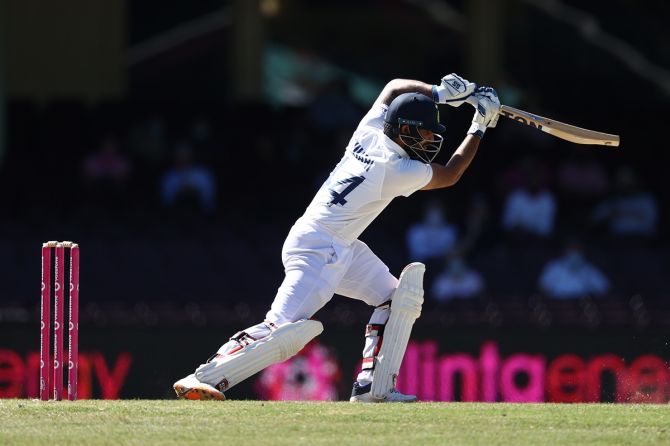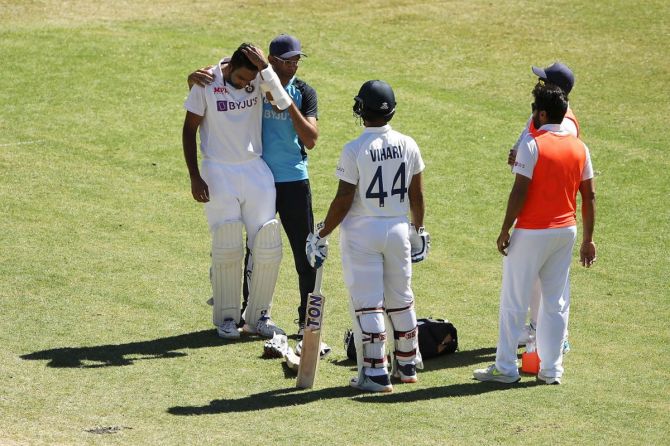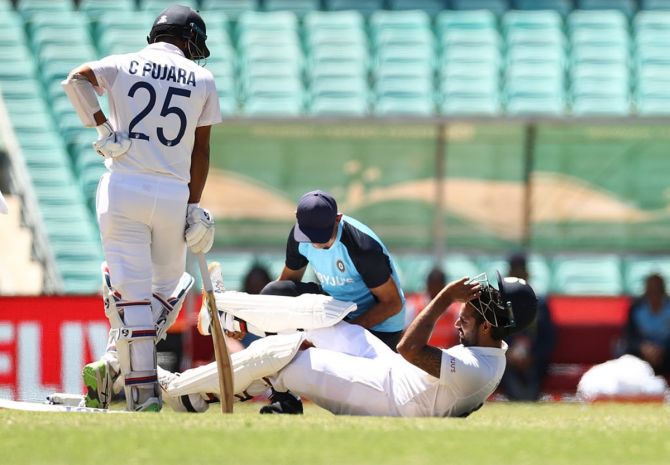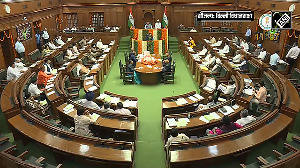As Ravichandran Ashwin achieved the milestone 100th Test in Mohali, everyone had their lists of his best bowling feats.
But Ashwin's finest cricketing moment was probably when he and Hanuma Vihari battled inhuman injury to draw the Sydney Test against Australia after India were bowled out for 36 in the first Test at Adelaide.
Bharat Sundaresan with Gaurav Joshi captures one of the greatest rearguard efforts in cricketing history. A gripping account from their must-read book, The Miracle Makers: Indian Cricket's Greatest Epic.

India were very much under siege when Ashwin joined Vihari in the middle. I had spotted the off spinner on multiple occasions during the first session of play on Day Five. I really thought Ashwin was simply being superstitious, especially during the wonderful Pujara-Pant partnership.
During the lunch break, I saw that Ashwin was on the balcony by himself. He was still not making the most of the rather comfortable chairs on the SCG visiting team dressing room balcony. It was then that I realized that maybe something was indeed wrong. As we know now, he'd bowled thirteen overs on the trot through excruciating pain, with nothing more than pills to suppress it, on Day Four, and even managed to get Smith out again.
He'd then needed his wife and kids to help him stand up the next morning, after having spent the night crawling and rolling on the floor.
And as Ashwin gingerly made his way out to the middle, he was greeted by someone who, amazingly, was much worse for wear than even him.

Hanuma Vihari had torn his hamstring in such a horrid fashion that he could barely move, forget walk or run. What Ashwin and Vihari ended up doing for the next two and a bit more hours would end up attaining legendary status.
It was Test cricket at its most primitive and raw state. A fight for survival against the best bowling attack in world cricket at that point. The next man in was Jadeja, who sat in the dressing room padded up and with his left glove on with heavy padding underneath to protect his broken thumb; he prepared to walk out and bat with one hand.
Cricket is littered with stories of cricketers taking the field wearing bandages over their heads and faces and various other parts of their bodies-except the fingers of course, since that would distract the batters' attention. But neither Ashwin nor Vihari had any bandages to show for their pain and agony.
One couldn't bend. The other couldn't move. But they were showing enough heart to make up for those deficiencies, and their attempts to thwart the Australians were working.

It was a unique position for the Aussies to be in, too. Yes, we've seen batting teams look to dead-bat their way towards a draw. But rarely would a bowling team have come across a couple of batters who literally wouldn't budge. So it was only natural, at some level, that the fast bowlers briefly forgot about getting them out and started focusing more on knocking and prising them out.
It meant more pain for Ashwin in particular as his body was used like a dart board by Hazlewood and Cummins.
But he simply refused to budge, despite being left coughing and grimacing in pain repeatedly.
Looking back, these sound like scenes from a movie. While there have already been a couple of documentaries made on this remarkable tour, I'd say the Ashwin-Vihari partnership deserves its own exclusive film.
And there was some crude element of romance added to the equation too, with the two batters exchanging chest guards and sticking it under their shirts at the back at the end of each over, much to the Aussies' frustration.

Ashwin still couldn't sit when they went in for the tea break. Vihari was putting not just his body but his career on the line with his show of courage. He was already ruled out of the next Test, and with no big score to show for his steadiness in this series, his efforts here just put his fearless attitude further into perspective.
'Vihari told him, "Come what may, I will not give my wicket away." That was when Ashwin walked up to him and said, "I will give you a stand." It was easier for Ashwin to play Lyon because he was able to stretch forward. Vihari couldn't stretch, and it was easier for him to play the fast bowlers. They took that decision by themselves,' Bharat Arun recalled.
The bowling coach described Ashwin as having been in a sort of special zone with bat in hand. The off spinner would later talk about how he had reached a point in his head where he didn't mind dying on the pitch for his country that day.
Arun said, 'After the game it took him thirty minutes to come out of that zone. He had been extremely consistent with the ball and produced probably his best overseas performance. He said, "Here lies an opportunity for me to show my grit in batting." He said later that he felt like a zombie for half hour after the game. That said so much about his commitment to the cause.'

At around 6.07 pm Sydney time, Jadeja finally took his gloves off in the dressing room. The Aussie bowlers had taken theirs off a while back but to no avail. Ashwin and Vihari had pulled off one of the greatest rearguard efforts in the history of the game.
If Test match cricket was all about character, India had won this game already.
Ajinkya Rahane nailed it in the end during the post-match presentation when he spoke about how the magnitude of India's achievement might not sink in tonight or even tomorrow. But it certainly would maybe after the series or in two months' time.
SCG 2021 was one of Indian cricket's greatest moments and will go down in cricketing history as such.
'It felt like a win for us. We'd also got their fast bowlers to bowl a lot of overs. We had come back from 36 all out, won in Melbourne and now pulled off this remarkable draw. We were euphoric and almost felt like the pressure was off us going into Brisbane,' Arun said.
I got a call very late at night, but not late enough for me to have finished my piece, from one of the head coaches. The euphoria was notable in his voice. You'd have thought that they'd already won the series. In some ways they had. The phone got passed around the room, and the other coaches chimed in with their own expressions of delirious joy.
The consensus was that if this wasn't the greatest Indian team ever, it certainly was the toughest Indian team of all time. You simply couldn't help but agree.
Excerpted from The Miracle Makers: Indian Cricket's Greatest Epic, by Bharat Sundaresan with Gaurav Joshi, with the kind permission of the publishers, Penguin Random House India.












 © 2025
© 2025